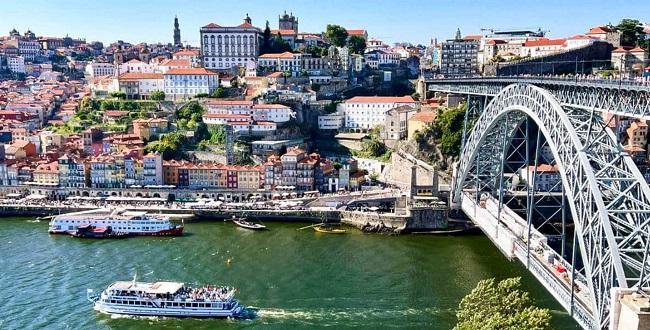Portugal, the western gem of the Iberian Peninsula, captivates visitors with its rich history, vibrant culture, and breathtaking landscapes. From the sun-kissed beaches of the Algarve to the historic streets of Lisbon and Porto, Portugal offers a diverse array of attractions.
Dive into our curated list of the top 10 most visited places in this enchanting country.

Top 10 Most Visited Places in Portugal
1. Lisbon – The Heart of Portugal
Overview
Lisbon, Portugal’s hilly, coastal capital city, is a hub of cultural and historical landmarks, framed by picturesque vistas and tram-lined streets.
Why Visit?
Explore the Jerónimos Monastery, Belem Tower, and stroll through the historic Alfama district. Don’t miss a taste of the famous pastel de nata at Pastéis de Belém.
2. Porto – The Wine Capital
Overview
Porto, known for its stately bridges and the production of port wine, offers a blend of artistic streets, baroque architecture, and waterfront cafes.
Why Visit?
Tour the cellars of Vila Nova de Gaia and experience a traditional Rabelo boat tour along the Douro River. The Livraria Lello bookstore is a must-see for book lovers.
3. Sintra – A Fairy-Tale Escape
Overview
Sintra is a UNESCO World Heritage site with opulent palaces, extravagant villas, and the ruins of an ancient castle nestled in the lush hills.
Why Visit?
Visit the colorful Pena Palace, the mysterious Quinta da Regaleira, and the Moorish Castle for a journey back in time.
4. Algarve – The Sunny South
Overview
The Algarve is famed for its Mediterranean beaches, golf resorts, scalloped bays, and sandy islands.
Why Visit?
Enjoy the stunning cliffs of Ponta da Piedade, relax on Praia da Marinha, and explore the seaside town of Lagos.
5. Coimbra – The University City
Overview
Coimbra, home to one of the oldest universities in Europe, exudes a scholarly atmosphere with its historic buildings and vibrant student life.
Why Visit?
Tour the University of Coimbra to see its baroque library, the Joanina Library, and enjoy the city’s medieval streets and the stunning views from the Santa Clara-a-Velha Monastery.
6. Madeira – The Pearl of the Atlantic
Overview
Madeira, an archipelago known for its lush landscapes, rugged coastline, and wine, offers a natural paradise for adventurers and relaxation seekers alike.
Why Visit?
Hike the levadas (irrigation channels) offering scenic paths through the mountains, visit the capital Funchal, and try the renowned Madeira wine.
7. Óbidos – The Medieval Town
Overview
Óbidos, encircled by a fortified wall, is a well-preserved example of medieval architecture. Its cobbled streets, traditional white houses, and vibrant cultural scene make it a charming destination.
Why Visit?
Walk the town walls for panoramic views, visit the castle, and sample the local cherry liqueur, Ginjinha, served in chocolate cups.
8. Évora – A Museum City
Overview
Évora is a UNESCO World Heritage site in the Alentejo region, rich in Roman history and known for its well-preserved old town center that still retains a large number of historical monuments.
Why Visit?
Explore the Roman Temple of Évora, the Chapel of Bones, and the Cathedral of Évora. The city is also a gateway to the Alentejo wine region.
9. Azores – The Green Archipelago
Overview
The Azores, a group of nine volcanic islands in the mid-Atlantic, are a haven of natural beauty, from hot mineral springs to crystal-clear waters and green pastures.
Why Visit?
Spot whales and dolphins on a boat tour, visit the Terra Nostra Park with its geothermal pools, and see the impressive Sete Cidades Massif.
10. Guimarães – The Birthplace of Portugal
Overview
Guimarães is often referred to as the birthplace of Portugal, with a well-preserved medieval center and a rich history that’s pivotal to the country’s identity.
Why Visit?
See the imposing Guimarães Castle, wander through the historic center, a UNESCO World Heritage site, and visit the Palace of the Dukes of Braganza.


















































